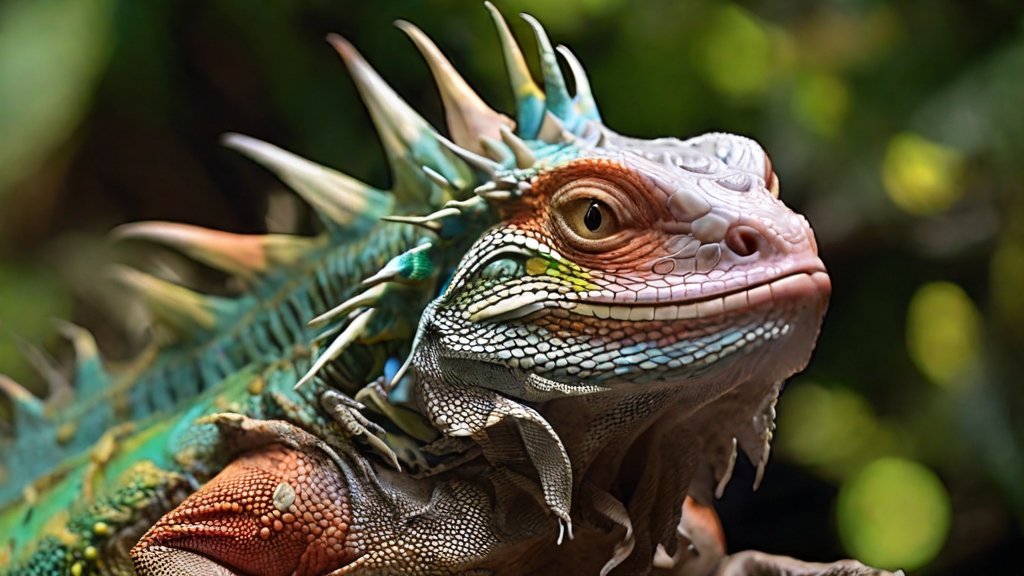Are iguanas truly capable of underwater respiration? This is a question that has intrigued many researchers and wildlife enthusiasts. Contrary to popular belief, iguanas cannot breathe underwater. While they are excellent swimmers and can hold their breath for extended periods, they rely on a unique set of adaptations to survive in diverse environments.
Understanding Iguanas’ Unique Adaptations
How do iguanas survive in diverse environments? Iguanas possess remarkable adaptations that enable them to thrive in various habitats, including both terrestrial and aquatic environments. Their ability to regulate body temperature, camouflage themselves, and efficiently digest plant matter make them versatile creatures.
While some species of iguanas are primarily terrestrial, others have embraced an aquatic lifestyle, taking advantage of the abundant resources found in the water.
The Anatomy of an Iguana: Respiratory System
Exploring the intricacies of iguanas’ respiratory organs sheds light on their ability to adapt in different environments. Iguanas possess lungs, just like humans and most other terrestrial animals. However, their respiratory system is designed to accommodate their semi-aquatic lifestyle.
Their lungs are relatively large, allowing for increased oxygen intake during periods of physical exertion. Additionally, iguanas have a well-developed diaphragm that aids in respiration.
Breathing Techniques: How Iguanas Adapt in Water
Unraveling the secrets of iguanas’ underwater breathing requires a closer look at their breathing techniques. When submerged, iguanas rely on anaerobic respiration, which means they do not take in oxygen from the water.
Instead, they store oxygen in their lungs and muscles before diving, enabling them to sustain their oxygen needs for extended periods. This adaptation allows them to explore underwater environments while their bodies efficiently conserve energy.
Do Iguanas Have Gills? The Truth Revealed
Debunking the misconception surrounding iguanas and gills is crucial to understanding their respiratory abilities. Unlike fish, which have gills to extract oxygen from water, iguanas do not possess gills. Their respiratory system is specifically designed for breathing air, although they can hold their breath and rely on stored oxygen while underwater.
This distinction is important in dispelling the myth of iguanas’ ability to breathe underwater through gills.
Aquatic Iguanas: The Marine Adventurers
Discover the remarkable iguanas that embrace aquatic lifestyles. One notable example is the marine iguana, found in the Galapagos Islands. These unique creatures have adapted to their surroundings by developing specialized traits.
Their flattened tails and spiky heads allow them to maneuver through the water with ease, while their sharp claws enable them to cling to rocks in turbulent currents. The marine iguanas have truly mastered the art of underwater exploration.
Iguanas’ Diving Abilities: How Deep Can They Go?
Unveiling the limits of iguanas’ diving capabilities is an ongoing area of study. While it varies among species, iguanas can typically dive to depths of around 30 feet. This ability allows them to forage for food underwater, such as algae and other aquatic plants.
Their exceptional swimming skills, combined with their efficient use of oxygen, enable them to navigate through challenging underwater environments in search of sustenance.
Adaptations for Underwater Survival: What We Know
Examining the physical attributes that enable iguanas to breathe underwater provides further insight into their remarkable adaptations. Iguanas have a highly muscular heart that pumps oxygen-rich blood throughout their bodies, ensuring essential organs receive adequate oxygen during dives.
Additionally, their ability to slow their heart rate and conserve energy while underwater contributes to their survival in challenging environments.
Respiration vs. Aquatic Foraging: Balancing Act for Iguanas
How do iguanas manage respiration while hunting underwater? It is indeed a balancing act for these reptiles. While they primarily rely on stored oxygen during dives, they must resurface periodically to replenish their oxygen levels.
This interplay between respiration and aquatic foraging requires precise timing and efficient use of energy. Iguanas have honed their instincts to ensure they maximize their foraging opportunities without compromising their respiratory needs.
Conservation Concerns: The Impacts on Iguanas’ Habitat
The importance of protecting the environments of aquatic iguanas cannot be overstated. Human activities, such as habitat destruction and pollution, pose significant threats to their habitats.
Conservation efforts aimed at preserving their natural habitats are crucial to ensuring the survival of these remarkable creatures.
By understanding and raising awareness about iguanas’ unique adaptations, we can contribute to their long-term conservation.
Conclusion: The Fascinating World of Iguanas’ Underwater Abilities
Summarizing the discoveries and ongoing research on iguanas’ underwater respiration reveals the fascinating world of these reptiles. While they cannot breathe underwater, iguanas have evolved to thrive in diverse environments, including aquatic habitats.
Their unique adaptations, extraordinary diving abilities, and efficient use of oxygen make them true marvels of the animal kingdom. By delving deeper into the secrets of iguanas’ underwater abilities, we unlock a deeper appreciation for the wonders of nature.




